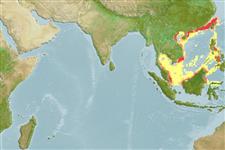Elasmobranchii (sharks and rays) >
Torpediniformes (Electric rays) >
Narcinidae (Numbfishes)
Etymology: Narcine: Greek, narke = numbness (Ref. 45335).
More on author: Shaw.
Environment: milieu / climate zone / depth range / distribution range
Ecology
Marine; demersal; depth range 30 - 80 m (Ref. 9912). Tropical; 27°N - 0°N, 78°E - 124°E (Ref. 114953)
Indo–West Pacific; Sri Lanka to south-west China (Hong Kong, Taiwan), and the Philippines.
Size / Weight / Age
Maturity: Lm ? range ? - ? cm
Max length : 40.0 cm TL male/unsexed; (Ref. 114953)
Occurs in inshore continental waters (Ref. 9912). Biology little known (Ref. 9912). Size usually smaller to 35 cm TL. Males reaches maturity smaller than 28 cm TL; born at ca. 13 cm TL (Ref. 114953). Used in Chinese medicine (Ref. 12166).
Life cycle and mating behavior
Maturities | Reproduction | Spawnings | Egg(s) | Fecundities | Larvae
de Carvalho, M.R., L.J.V. Compagno and P.R. Last, 1999. Narcinidae. Numbfishes. p. 1433-1442. In K.E. Carpenter and V.H. Niem (eds.) FAO species identification guide for fishery purposes. The living marine resources of the Western Central Pacific. Vol. 3. Batoid fishes, chimaeras and bony fishes. Part 1 (Elopidae to Linophrynidae). FAO, Rome. (Ref. 9912)
IUCN Red List Status (Ref. 130435)
Threat to humans
Harmless
Human uses
Tools
Special reports
Download XML
Internet sources
Estimates based on models
Preferred temperature (Ref.
123201): 23.5 - 28.4, mean 27.5 °C (based on 277 cells).
Phylogenetic diversity index (Ref.
82804): PD
50 = 0.5000 [Uniqueness, from 0.5 = low to 2.0 = high].
Bayesian length-weight: a=0.01175 (0.00476 - 0.02897), b=2.88 (2.66 - 3.10), in cm total length, based on LWR estimates for this (Sub)family-body shape (Ref.
93245).
Trophic level (Ref.
69278): 3.1 ±0.3 se; based on size and trophs of closest relatives
Resilience (Ref.
120179): Low, minimum population doubling time 4.5 - 14 years (Assuming fecundity<100).
Fishing Vulnerability (Ref.
59153): Low to moderate vulnerability (30 of 100).
